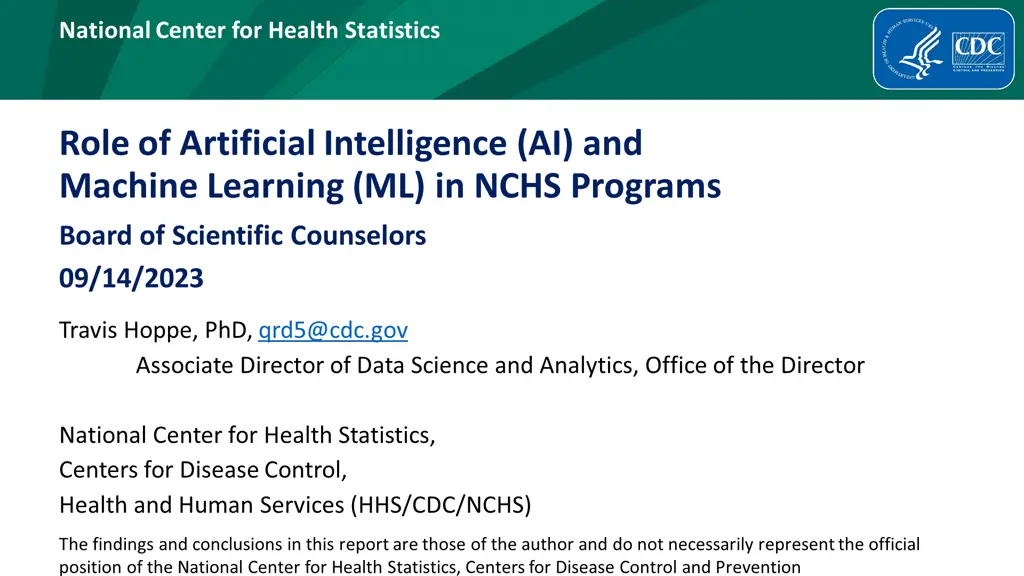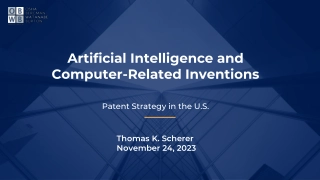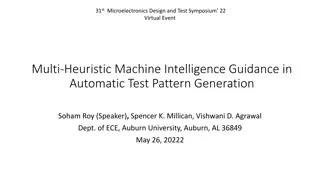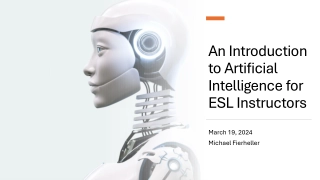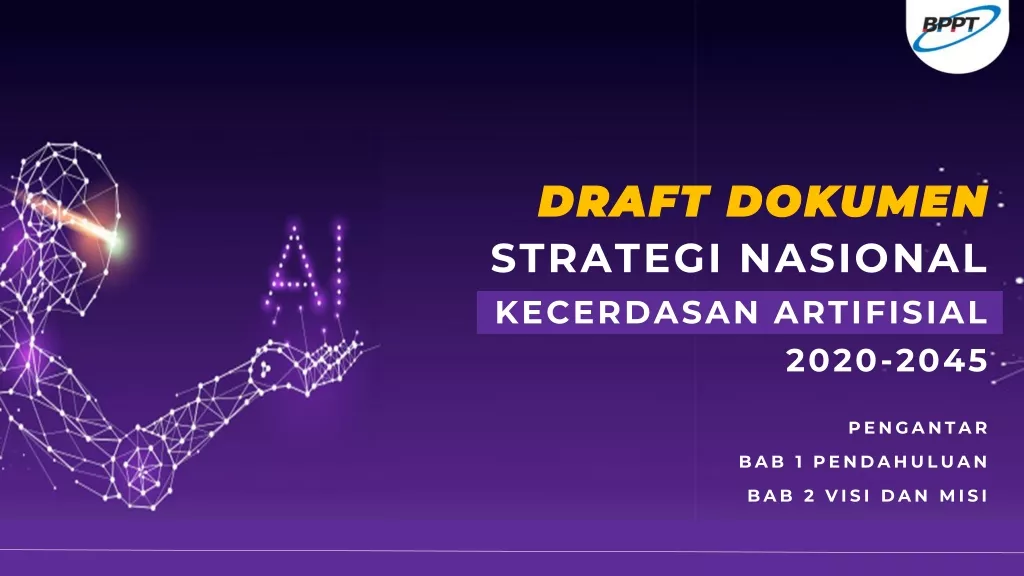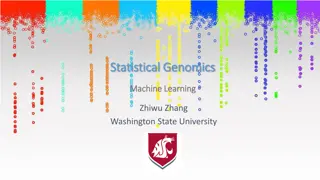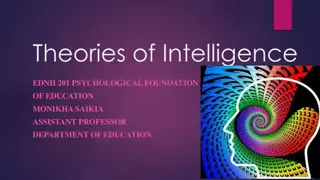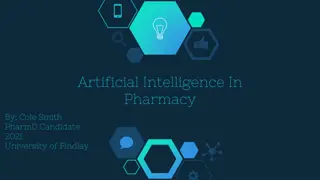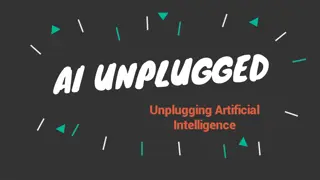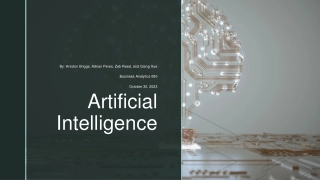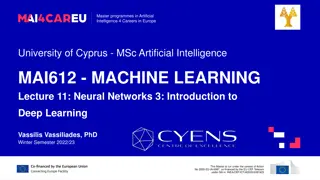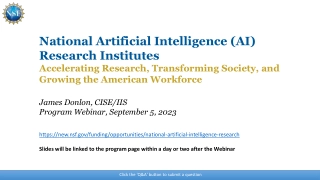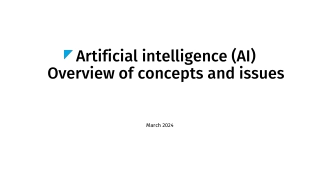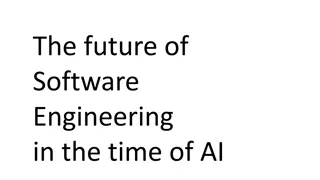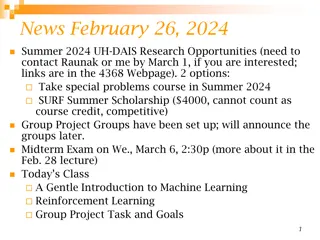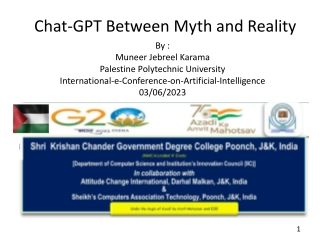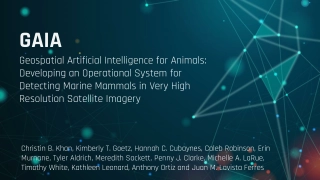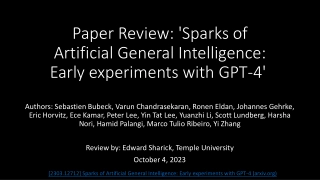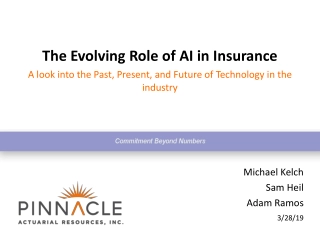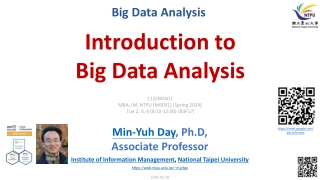Role of Artificial Intelligence (AI) and Machine Learning (ML) in NCHS Programs
Discover how the National Center for Health Statistics utilizes AI and ML in diverse programs, enhancing efficiency and accuracy through innovative applications. Explore the implications of Trustworthy AI initiatives and generative AI frameworks in federal healthcare programs.
Download Presentation

Please find below an Image/Link to download the presentation.
The content on the website is provided AS IS for your information and personal use only. It may not be sold, licensed, or shared on other websites without obtaining consent from the author. Download presentation by click this link. If you encounter any issues during the download, it is possible that the publisher has removed the file from their server.
E N D
Presentation Transcript
National Center for Health Statistics Role of Artificial Intelligence (AI) and Machine Learning (ML) in NCHS Programs Board of Scientific Counselors 09/14/2023 Travis Hoppe, PhD, qrd5@cdc.gov Associate Director of Data Science and Analytics, Office of the Director National Center for Health Statistics, Centers for Disease Control, Health and Human Services (HHS/CDC/NCHS) The findings and conclusions in this report are those of the author and do not necessarily represent the official position of the National Center for Health Statistics, Centers for Disease Control and Prevention
NCHS AI activities, per EO 13960 (Trustworthy AI) Developed in house SANDS: Semi-automated non-response detection, live model release MedCoder: Coding cause of death information to ICD-10 Detecting Stimulant and Opioid Misuse and Illicit Use in EHRs Commercial-off-the-shelf or open-source implementation Whisper: Speech to text (CCQDER) improvement, 20x improvement Private AI: PII detection model used for FOIA requests Governance, policy, and strategic planning Utility and Risks to CDC of Conversational Artificial Intelligence
(Generative) AI at across the Federal government NCHS CDC HHS USG NCHS led the development of a generative AI whitepaper NCHS is helping lead a new CDC AI Community of Practice OPHDST is developing a FedRamp approved ChatGPT interface CDC is drafting an AI strategy, including generative AI HHS published the 2023 AI inventory Guiding Frameworks: NIST AI RMF, HHS Trustworthy AI Playbook, and upcoming OMB guidance on generative AI
Trustworthy AI initiatives in the federal government 2019 2020 2021 2022 2023
Potential benefits of generative AI for CDC Potential benefit to CDC Save resources: Automate or accelerate certain tasks and processes Examples Draft an executive summary of a written report from talking points Draft a chart abstraction questionnaire Draft a scope of work for a contract Draft a position description for a vacant job Draft or edit scientific products including abstracts and manuscripts Create resumes or other structured documents Create or edit code and documentation Translate code between programming languages Summarize written material Describe methodological options, with references, for conducting multiple imputation at scale Draft communications messages Translate websites or other written materials between spoken languages Draft tweets from a list of talking points. Draft responses to public inquiries with references to relevant CDC guidance Increase efficiency: Accelerate manual or repetitive tasks that do not require a high level of expertise or using structured formats Synthesize and summarize information Communicate: Adapting text to various reading levels, platforms, audiences Personalize responses CDC Tiger Team, "Utility and Risks to CDC of Conversational Artificial Intelligence (AI) Technologies Like ChatGPT"
Potential risks of generative AI for CDC Potential harm to CDC Failure to meet ethical or regulatory standards Examples Relevant regulations and policies that could be threatened by AI use include those addressing data accuracy, data security and privacy/confidentiality, intellectual property, health equity, discrimination, and scientific integrity. Conversational AI may hallucinate or fabricate information including data and references has been reported widely. Fabrication, falsification, and plagiarism are included in the federal definition of reportable research misconduct. Conversational AI technology is trained on vast amounts of data from undisclosed sources, and tone and content may include biases, misconceptions, or outdated information regarding specific populations Cloud-based models rely on external infrastructure, which may not always be compliant with the strict security standards required in the healthcare sector or by federal assurances. Transparency, oversight, and accountability for AI-generated material can be unclear. Fabrication Bias and discrimination Lack of privacy and data security Other legal or ethical risks, including risks to agency credibility CDC Tiger Team, "Utility and Risks to CDC of Conversational Artificial Intelligence (AI) Technologies Like ChatGPT"
CDC should anticipate malicious use by external actors Potential action Generating misinformation Examples External actors might generate large volumes of text-based communications that include unintentional errors or propagate misinformation. Misinformation may use various strategies to appear credible, such as using scientific language or citing references. External actors might use ChatGPT to imitate CDC or other public health authorities ( deepfakes ) or hallucinated written material falsely attributed to CDC. CDC may need to expend resources explaining or debunking information falsely attributed to CDC, including requests to verify statements, publications, or guidance. In platforms for public communication where CDC is required or obligated to respond, external actors might spam CDC with large volumes of credible inquiries. This includes public comments (including on government documents or at open government meetings), public inquiries to CDC (including CDC-Info and NIP-Info), social media comments and inquiries, and media or other requests for CDC response. Recently, volume of public comments at a CDC ACIP in late 2022 increased from an anticipated 600 comments to 127,000 comments (unknown proportion AI). Impersonating CDC Spamming CDC CDC Tiger Team, "Utility and Risks to CDC of Conversational Artificial Intelligence (AI) Technologies Like ChatGPT"
National Center for Health Statistics State of AI: How we got here and current capabilities Board of Scientific Counselors 09/14/2023 Ben Rogers, MS, qtw4@cdc.gov Data Scientist, Division of Research and Methodology National Center for Health Statistics, Centers for Disease Control, Health and Human Services (HHS/CDC/NCHS) The findings and conclusions in this report are those of the author and do not necessarily represent the official position of the National Center for Health Statistics, Centers for Disease Control and Prevention
Considerations for the BSC: 1. How can NCHS and other statistical agencies benefit from AI/ML? 2. What role should federal agencies take in the AI/ML research space given the rapid innovation?
State of AI key take aways: Recent innovations in technology and data have spurred massive growth in the capabilities of AI Existing text/audio/images workflows can be augmented with AI Advances in AI/Machine Learning are not slowing down Emergent capabilities in larger models not present in smaller models Open source models and data help AI adoption and innovation
Using definitions of AI and Machine Learning from NIST: AI: Interdisciplinary field, usually regarded as a branch of computer science, dealing with models and systems for the performance of functions generally associated with human intelligence, such as reasoning and learning. * Machine Learning: The study of computer algorithms that improve automatically through experience.* * National Institute of Standards and Technology Language of Trustworthy AI: In-Depth Glossary of Terms
It starts with Moores Law What is Moore s Law? - Our World in Data Graphic created by Hannah Ritchie and Max Roser available on Our World in Data.
Implication: Exponential growth in computing power Computational capacity of the fastest supercomputers (ourworldindata.org)
Implication: Large availability of affordable data storage Historical cost of computer memory and storage (ourworldindata.org)
Implication: Increased data availability Data are available through web-scraping, research article platforms, etc. This includes any text, image, audio, video in the public domain Anything available on CDC.gov, NCHS s discontinued blog nchstats.com, etc. Google s Colossal Clean Crawled Corpus introduced in https://arxiv.org/abs/1910.10683v3 https://www.washingtonpost.com/technology/interactive/2023/ai-chatbot-learning/
Application: Foundational AI models Example: LLaMa 2 family of Large Language Models Trained on Meta s Research SuperCluster Estimated cost of computing with Microsoft Azure ~$4.5 Million** Chat GPT and other famous Conversational AI models assumed to be on the same magnitude of computational cost Training foundational AI models at this scale requires thousands of data-center grade GPUs which are rare and in high demand internationally *[2307.09288] Llama 2: Open Foundation and Fine-Tuned Chat Models (arxiv.org) **Using cost of $1.3631 per hour of A100 GPU on Azure platform where LLaMa2 used 3,311,616 GPU hours
Application: open source foundational models available for data scientists Foundational models are available to fine tune either through open-source (LLaMa2*) or paid access (Chat GPT**) Vastly cheaper to fine tune these pre-trained models OpenAI FedRAMP authorized through Microsoft Azure*** Zero-shot/Few-shot classification from transfer learning enable high-performance on classification tasks with off-the-shelf models *https://ai.meta.com/llama/ ***https://devblogs.microsoft.com/azuregov/azure-openai-service-achieves-fedramp-high-authorization/ **https://platform.openai.com/docs/guides/fine-tuning
Potential AI tasks considered by NCHS staff Text: Translation, code generation, summarization, conversational text generation, classification, named entity recognition, PII detection, topic modeling Vision: Classification, generation, segmentation Audio: Transcription, translation, generation, speaker identification
Use of machine learning for nowcasting suicide fatalities in the U.S. CDC s National Center for Injury Prevention and Control has leveraged machine learning and artificial neural networks to integrate several streams of information to estimate weekly suicide fatalities in the U.S. in near real time. The ensemble machine learning framework reduces the error for suicide rate estimation, establishes a novel approach for tracking suicide fatalities in near real time, and provides the potential for an effective public health response and interventions to prevent suicides in the U.S. Development of a Machine Learning Model Using Multiple, Heterogeneous Data Sources to Estimate Weekly US Suicide Fatalities - PubMed (nih.gov)
HaMLET: Harnessing Machine Learning to Eliminate Tuberculosis At CDC, data scientists are exploring ways to use machine learning to leverage chest x-ray and tuberculosis data from overseas immigration visa screening examinations of immigrants and refugees to enhance programs to detect and treat tuberculosis (TB) to prevent TB importation. The computer vision model detects abnormal findings suggestive of TB in chest x- rays and can identify results that are discordant with the radiologist s findings https://github.com/scotthlee/hamlet
Transcribing cognitive interviews Transcriptions have had a 69.8% decrease in errors in 2 years Previous CCQDER Transcription software has a word error rate of 68.4 on Cognitive interviews *2020 state-of-the-art transcription model Wav2Vec2-large-960h had a word error rate on FLEURS.en_us is 14.6 *2022 state-of-the-art transcription model Whisper word error rate on FLEURS.en_us is 4.4 Transcription errors dropped from 1 in 2 words to 1 in 25 when applied to cognitive interviews conducted by NCHS staff * Robust Speech Recognition via Large-Scale Weak Supervision
Semi-Automated Non-response Detection for Surveys SANDS is a non-response detection AI model designed to be used for data cleaning for open-ended survey text in conjunction with human reviewers. NCHS/SANDS Hugging Face Semi-Automated Non-response Detection for Surveys (cdc.gov)
